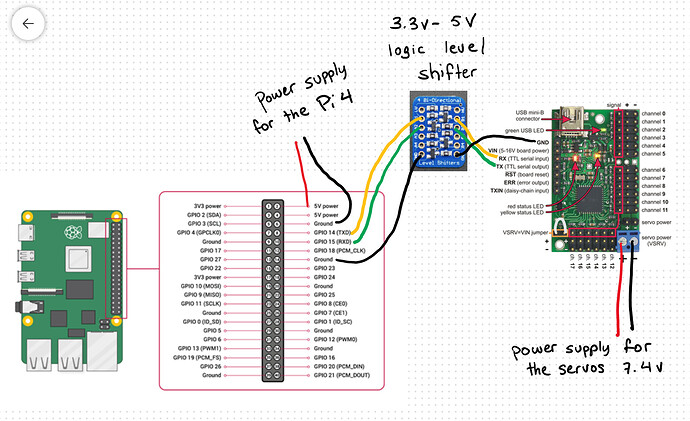I want to power the Raspberry directly from the Maestro 18pin servo controller board, since that only one battery is needed. However, the servos operate at 7.4 volts (so the battery is 7.4 volts as well) but the Raspberry Pi operates at 5v (f I’m not wrong). I don’t want to break anything so I was wondering what is the best way to power the Pi board form the Maestro controller board.
I’m new to electronics, so a detailed answer would be much appreciated!
Hello.
The Mini Maestro has a 5V regulated output, but it can only supply about 50mA which is not sufficient for powering a Raspberry Pi. A better approach would probably be to power your Raspberry Pi from your battery using an appropriate step-down regulator, like perhaps our D36V28F5.
- Patrick
Hi, thanks very much.
There a few other things I want to be sure about:
-Is the maestro board connected to the servo power supply? (In this case 7.4 volt) or is it separate? I saw that it was possible to power the board by adding a wire between VIN and the servo power supply pin. So I assume that the board is separate and can accept higher voltages?
-If I choose to connect my 7.4 volt power supply to the VIN as well to power the maestro, do I still need to have the GND plugged or is it not necessary?
-I only need to send signals to the servos from the raspberry pi, so I’ll connect the RX to TX. Do I still need to ground the maestro board if it uses the battery as it’s power supply?
Thank you!
Oh and also, would it be easier if I power the maestro board directly from the raspberry pi?
In that case I would have the servos run on a 7.4v battery while I’ll have the VIN connected to the raspberry pi 5v out, RX connected to TX, and both GND connected. Would that work or could that damage the raspberry Pi? It would be something similar to this:
Thanks for the response!
(original image from https://electronicsmusiclifestyle.wordpress.com/2017/09/07/comprehensive-explanation-of-the-maestro-pi3-interfacing/)
By default, connecting power to the servo power bus will not power the Maestro itself. However, you can configure the Maestro so that your servos and Maestro are powered from the same supply (in which case the power supply must be between 5V and 16V). On the 18-channel Mini Maestro you have the recommended way to do that is to connect your power supply to the dedicated servo power pins in the corner of the board and use the included blue shorting block to connect the pins labeled “VSRV=VIN”. You can find more information about that in the “Powering the Maestro” section of the Maestro user’s guide.
All of the GND pins on the Maestro are connected by the PCB, so if you are only using one source to power it, you do not need to connect your source to GND in multiple locations.
Your Maestro should share a common ground with all other electronics it is connected to, and ideally these connections should all be as direct as possible. So, I would recommend connecting ground between your Raspberry Pi and Maestro.
I suspect powering your Maestro from the same supply as your servos will be better for your application, but it might be okay to power your Maestro from the Raspberry Pi and power your servos separately. There is information about how to power the Maestro using two supplies in the user’s guide section I linked to earlier. The limiting factor will be whether your Raspberry Pi can sufficiently power the Maestro which will depend on what else is connected to your Raspberry Pi. Also, keep in mind 5V is at the bottom edge of the Maestro’s power range, so any dips could cause the Maestro to lose power.
- Patrick
Thank you very much for your help. So if I’m not wrong, this wiring should work:
- I have the Raspberry Pi powered by an external 5v supply.
- The servo battery (7.4v) is connected to the servo power lines, with the VSRV=VIN pin connected to the VIN pin which is right next to it (if I’m not wrong from the documentation) That should power the meastro board
- The GND of the maestro is connected to the GND of the Pi4
- I have a 3.3v-5v level shifter for the signal (I read that it was optimal to make sure the signals go through)
Does that seem okay? Or are there any problems with this configuration?
Thank you again so much for the help!
That wiring diagram looks great to me!
- Patrick


